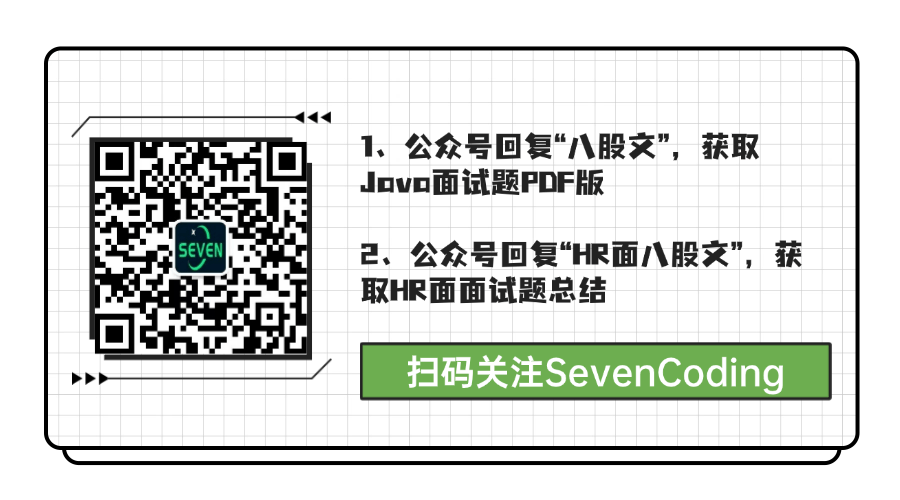动态代理概述
什么是代理
代理模式(Proxy pattern): 为另一个对象提供一个替身或占位符以控制对这个对象的访问
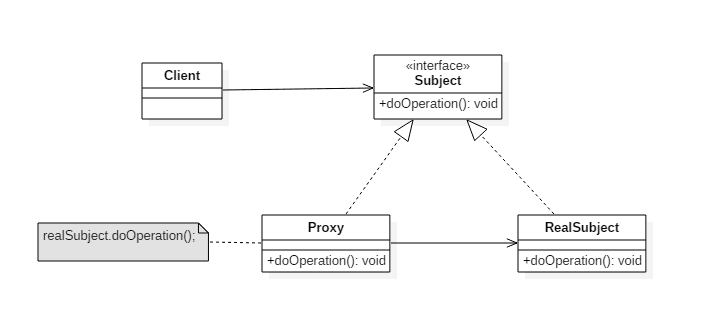
什么是动态代理?
动态代理就是,在程序运行期,创建目标对象的代理对象,并对目标对象中的方法进行功能性增强的一种技术。
在生成代理对象的过程中,目标对象不变,代理对象中的方法是目标对象方法的增强方法。可以理解为运行期间,对象中方法的动态拦截,在拦截方法的前后执行功能操作。
代理的创建
创建代理的方法是postProcessAfterInitialization:如果bean被子类标识为代理,则使用配置的拦截器创建一个代理
/**
* Create a proxy with the configured interceptors if the bean is
* identified as one to proxy by the subclass.
* @see #getAdvicesAndAdvisorsForBean
*/
@Override
public Object postProcessAfterInitialization(@Nullable Object bean, String beanName) {
if (bean != null) {
Object cacheKey = getCacheKey(bean.getClass(), beanName);
// 如果不是提前暴露的代理
if (this.earlyProxyReferences.remove(cacheKey) != bean) {
return wrapIfNecessary(bean, beanName, cacheKey);
}
}
return bean;
}wrapIfNecessary方法主要用于判断是否需要创建代理,如果Bean能够获取到advisor才需要创建代理
/**
* Wrap the given bean if necessary, i.e. if it is eligible for being proxied.
* @param bean the raw bean instance
* @param beanName the name of the bean
* @param cacheKey the cache key for metadata access
* @return a proxy wrapping the bean, or the raw bean instance as-is
*/
protected Object wrapIfNecessary(Object bean, String beanName, Object cacheKey) {
// 如果bean是通过TargetSource接口获取
if (beanName != null && this.targetSourcedBeans.contains(beanName)) {
return bean;
}
// 如果bean是切面类
if (Boolean.FALSE.equals(this.advisedBeans.get(cacheKey))) {
return bean;
}
// 如果是aop基础类?是否跳过?
if (isInfrastructureClass(bean.getClass()) || shouldSkip(bean.getClass(), beanName)) {
this.advisedBeans.put(cacheKey, Boolean.FALSE);
return bean;
}
// 重点:获取所有advisor,如果没有获取到,那说明不要进行增强,也就不需要代理了。
Object[] specificInterceptors = getAdvicesAndAdvisorsForBean(bean.getClass(), beanName, null);
if (specificInterceptors != DO_NOT_PROXY) {
this.advisedBeans.put(cacheKey, Boolean.TRUE);
// 重点:创建代理
Object proxy = createProxy(
bean.getClass(), beanName, specificInterceptors, new SingletonTargetSource(bean));
this.proxyTypes.put(cacheKey, proxy.getClass());
return proxy;
}
this.advisedBeans.put(cacheKey, Boolean.FALSE);
return bean;
}获取所有的Advisor
我们看下获取所有advisor的方法getAdvicesAndAdvisorsForBean
@Override
@Nullable
protected Object[] getAdvicesAndAdvisorsForBean(
Class<?> beanClass, String beanName, @Nullable TargetSource targetSource) {
List<Advisor> advisors = findEligibleAdvisors(beanClass, beanName);
if (advisors.isEmpty()) {
return DO_NOT_PROXY;
}
return advisors.toArray();
}通过findEligibleAdvisors方法获取advisor, 如果获取不到返回DO_NOT_PROXY(不需要创建代理),findEligibleAdvisors方法如下
/**
* Find all eligible Advisors for auto-proxying this class.
* @param beanClass the clazz to find advisors for
* @param beanName the name of the currently proxied bean
* @return the empty List, not {@code null},
* if there are no pointcuts or interceptors
* @see #findCandidateAdvisors
* @see #sortAdvisors
* @see #extendAdvisors
*/
protected List<Advisor> findEligibleAdvisors(Class<?> beanClass, String beanName) {
// 和上文一样,获取所有切面类的切面方法生成Advisor
List<Advisor> candidateAdvisors = findCandidateAdvisors();
// 找到这些Advisor中能够应用于beanClass的Advisor
List<Advisor> eligibleAdvisors = findAdvisorsThatCanApply(candidateAdvisors, beanClass, beanName);
// 如果需要,交给子类拓展
extendAdvisors(eligibleAdvisors);
// 对Advisor排序
if (!eligibleAdvisors.isEmpty()) {
eligibleAdvisors = sortAdvisors(eligibleAdvisors);
}
return eligibleAdvisors;
}获取所有切面类的切面方法生成Advisor
/**
* Find all candidate Advisors to use in auto-proxying.
* @return the List of candidate Advisors
*/
protected List<Advisor> findCandidateAdvisors() {
Assert.state(this.advisorRetrievalHelper != null, "No BeanFactoryAdvisorRetrievalHelper available");
return this.advisorRetrievalHelper.findAdvisorBeans();
}找到这些Advisor中能够应用于beanClass的Advisor
/**
* Determine the sublist of the {@code candidateAdvisors} list
* that is applicable to the given class.
* @param candidateAdvisors the Advisors to evaluate
* @param clazz the target class
* @return sublist of Advisors that can apply to an object of the given class
* (may be the incoming List as-is)
*/
public static List<Advisor> findAdvisorsThatCanApply(List<Advisor> candidateAdvisors, Class<?> clazz) {
if (candidateAdvisors.isEmpty()) {
return candidateAdvisors;
}
List<Advisor> eligibleAdvisors = new ArrayList<>();
for (Advisor candidate : candidateAdvisors) {
// 通过Introduction实现的advice
if (candidate instanceof IntroductionAdvisor && canApply(candidate, clazz)) {
eligibleAdvisors.add(candidate);
}
}
boolean hasIntroductions = !eligibleAdvisors.isEmpty();
for (Advisor candidate : candidateAdvisors) {
if (candidate instanceof IntroductionAdvisor) {
// already processed
continue;
}
// 是否能够应用于clazz的Advice
if (canApply(candidate, clazz, hasIntroductions)) {
eligibleAdvisors.add(candidate);
}
}
return eligibleAdvisors;
}创建代理的入口方法
获取所有advisor后,如果有advisor,则说明需要增强,即需要创建代理,创建代理的方法如下:
/**
* Create an AOP proxy for the given bean.
* @param beanClass the class of the bean
* @param beanName the name of the bean
* @param specificInterceptors the set of interceptors that is
* specific to this bean (may be empty, but not null)
* @param targetSource the TargetSource for the proxy,
* already pre-configured to access the bean
* @return the AOP proxy for the bean
* @see #buildAdvisors
*/
protected Object createProxy(Class<?> beanClass, @Nullable String beanName,
@Nullable Object[] specificInterceptors, TargetSource targetSource) {
if (this.beanFactory instanceof ConfigurableListableBeanFactory) {
AutoProxyUtils.exposeTargetClass((ConfigurableListableBeanFactory) this.beanFactory, beanName, beanClass);
}
ProxyFactory proxyFactory = new ProxyFactory();
proxyFactory.copyFrom(this);
if (proxyFactory.isProxyTargetClass()) {
// Explicit handling of JDK proxy targets (for introduction advice scenarios)
if (Proxy.isProxyClass(beanClass)) {
// Must allow for introductions; can't just set interfaces to the proxy's interfaces only.
for (Class<?> ifc : beanClass.getInterfaces()) {
proxyFactory.addInterface(ifc);
}
}
}
else {
// No proxyTargetClass flag enforced, let's apply our default checks...
if (shouldProxyTargetClass(beanClass, beanName)) {
proxyFactory.setProxyTargetClass(true);
}
else {
evaluateProxyInterfaces(beanClass, proxyFactory);
}
}
Advisor[] advisors = buildAdvisors(beanName, specificInterceptors);
proxyFactory.addAdvisors(advisors);
proxyFactory.setTargetSource(targetSource);
customizeProxyFactory(proxyFactory);
proxyFactory.setFrozen(this.freezeProxy);
if (advisorsPreFiltered()) {
proxyFactory.setPreFiltered(true);
}
// Use original ClassLoader if bean class not locally loaded in overriding class loader
ClassLoader classLoader = getProxyClassLoader();
if (classLoader instanceof SmartClassLoader && classLoader != beanClass.getClassLoader()) {
classLoader = ((SmartClassLoader) classLoader).getOriginalClassLoader();
}
return proxyFactory.getProxy(classLoader);
}proxyFactory.getProxy(classLoader)
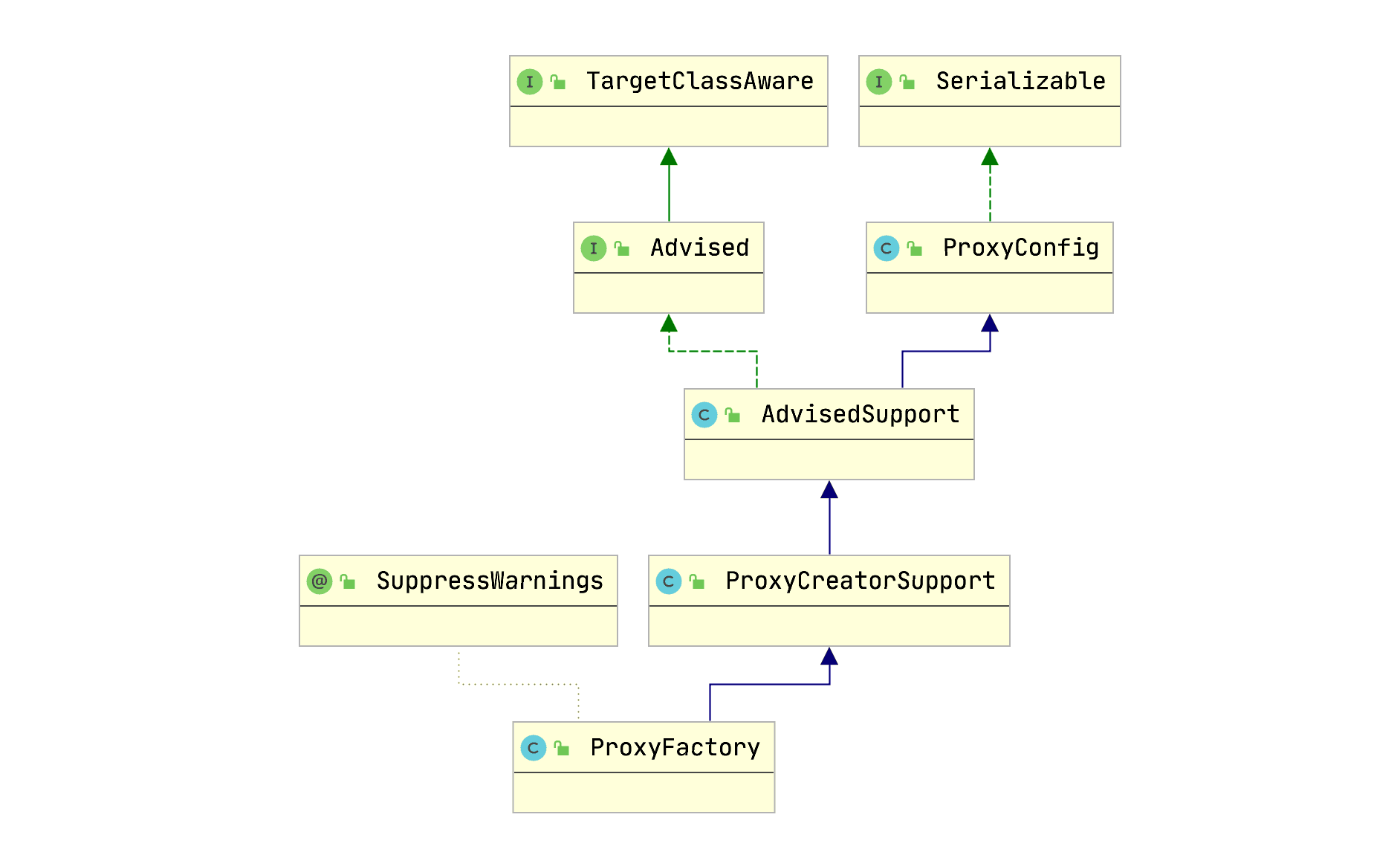
/**
* Create a new proxy according to the settings in this factory.
* <p>Can be called repeatedly. Effect will vary if we've added
* or removed interfaces. Can add and remove interceptors.
* <p>Uses the given class loader (if necessary for proxy creation).
* @param classLoader the class loader to create the proxy with
* (or {@code null} for the low-level proxy facility's default)
* @return the proxy object
*/
public Object getProxy(@Nullable ClassLoader classLoader) {
return createAopProxy().getProxy(classLoader);
}依据条件创建代理(jdk或cglib)
DefaultAopProxyFactory.createAopProxy
@Override
public AopProxy createAopProxy(AdvisedSupport config) throws AopConfigException {
if (!NativeDetector.inNativeImage() &&
(config.isOptimize() || config.isProxyTargetClass() || hasNoUserSuppliedProxyInterfaces(config))) {
Class<?> targetClass = config.getTargetClass();
if (targetClass == null) {
throw new AopConfigException("TargetSource cannot determine target class: " +
"Either an interface or a target is required for proxy creation.");
}
if (targetClass.isInterface() || Proxy.isProxyClass(targetClass)) {
return new JdkDynamicAopProxy(config);
}
return new ObjenesisCglibAopProxy(config);
}
else {
return new JdkDynamicAopProxy(config);
}
}小结
- config.isOptimize() 是通过optimize设置,表示配置是自定义的,默认是false;
- config.isProxyTargetClass()是通过
<aop:config proxy-target-class="true" />来配置的,表示优先使用cglib代理,默认是false; - hasNoUserSuppliedProxyInterfaces(config) 表示是否目标类实现了接口
由此可以知道:
Spring默认在目标类实现接口时是通过JDK代理实现的,只有非接口的是通过Cglib代理实现的。当设置proxy-target-class为true时在目标类不是接口或者代理类时优先使用cglib代理实现。
JDK代理
JDK动态代理是有JDK提供的工具类Proxy实现的,动态代理类是在运行时生成指定接口的代理类,每个代理实例(实现需要代理的接口)都有一个关联的调用处理程序对象,此对象实现了InvocationHandler,最终的业务逻辑是在InvocationHandler实现类的invoke方法上。
JDK代理的流程如下:
JDK代理自动生成的class是由sun.misc.ProxyGenerator来生成的。
ProxyGenerator生成代码
我们看下sun.misc.ProxyGenerator生成代码的逻辑:
/**
* Generate a proxy class given a name and a list of proxy interfaces.
*
* @param name the class name of the proxy class
* @param interfaces proxy interfaces
* @param accessFlags access flags of the proxy class
*/
public static byte[] generateProxyClass(final String name,
Class<?>[] interfaces,
int accessFlags)
{
ProxyGenerator gen = new ProxyGenerator(name, interfaces, accessFlags);
final byte[] classFile = gen.generateClassFile();
...
}generateClassFile方法如下:
/**
* Generate a class file for the proxy class. This method drives the
* class file generation process.
*/
private byte[] generateClassFile() {
/* 第一步:将所有方法包装成ProxyMethod对象 */
// 将Object类中hashCode、equals、toString方法包装成ProxyMethod对象
addProxyMethod(hashCodeMethod, Object.class);
addProxyMethod(equalsMethod, Object.class);
addProxyMethod(toStringMethod, Object.class);
// 将代理类接口方法包装成ProxyMethod对象
for (Class<?> intf : interfaces) {
for (Method m : intf.getMethods()) {
addProxyMethod(m, intf);
}
}
// 校验返回类型
for (List<ProxyMethod> sigmethods : proxyMethods.values()) {
checkReturnTypes(sigmethods);
}
/* 第二步:为代理类组装字段,构造函数,方法,static初始化块等 */
try {
// 添加构造函数,参数是InvocationHandler
methods.add(generateConstructor());
// 代理方法
for (List<ProxyMethod> sigmethods : proxyMethods.values()) {
for (ProxyMethod pm : sigmethods) {
// 字段
fields.add(new FieldInfo(pm.methodFieldName,
"Ljava/lang/reflect/Method;",
ACC_PRIVATE | ACC_STATIC));
// 上述ProxyMethod中的方法
methods.add(pm.generateMethod());
}
}
// static初始化块
methods.add(generateStaticInitializer());
} catch (IOException e) {
throw new InternalError("unexpected I/O Exception", e);
}
if (methods.size() > 65535) {
throw new IllegalArgumentException("method limit exceeded");
}
if (fields.size() > 65535) {
throw new IllegalArgumentException("field limit exceeded");
}
/* 第三步:写入class文件 */
/*
* Make sure that constant pool indexes are reserved for the
* following items before starting to write the final class file.
*/
cp.getClass(dotToSlash(className));
cp.getClass(superclassName);
for (Class<?> intf: interfaces) {
cp.getClass(dotToSlash(intf.getName()));
}
/*
* Disallow new constant pool additions beyond this point, since
* we are about to write the final constant pool table.
*/
cp.setReadOnly();
ByteArrayOutputStream bout = new ByteArrayOutputStream();
DataOutputStream dout = new DataOutputStream(bout);
try {
/*
* Write all the items of the "ClassFile" structure.
* See JVMS section 4.1.
*/
// u4 magic;
dout.writeInt(0xCAFEBABE);
// u2 minor_version;
dout.writeShort(CLASSFILE_MINOR_VERSION);
// u2 major_version;
dout.writeShort(CLASSFILE_MAJOR_VERSION);
cp.write(dout); // (write constant pool)
// u2 access_flags;
dout.writeShort(accessFlags);
// u2 this_class;
dout.writeShort(cp.getClass(dotToSlash(className)));
// u2 super_class;
dout.writeShort(cp.getClass(superclassName));
// u2 interfaces_count;
dout.writeShort(interfaces.length);
// u2 interfaces[interfaces_count];
for (Class<?> intf : interfaces) {
dout.writeShort(cp.getClass(
dotToSlash(intf.getName())));
}
// u2 fields_count;
dout.writeShort(fields.size());
// field_info fields[fields_count];
for (FieldInfo f : fields) {
f.write(dout);
}
// u2 methods_count;
dout.writeShort(methods.size());
// method_info methods[methods_count];
for (MethodInfo m : methods) {
m.write(dout);
}
// u2 attributes_count;
dout.writeShort(0); // (no ClassFile attributes for proxy classes)
} catch (IOException e) {
throw new InternalError("unexpected I/O Exception", e);
}
return bout.toByteArray();
}一共三个步骤(把大象装进冰箱分几步?):
- 第一步:(把冰箱门打开)准备工作,将所有方法包装成ProxyMethod对象,包括Object类中hashCode、equals、toString方法,以及被代理的接口中的方法
- 第二步:(把大象装进去)为代理类组装字段,构造函数,方法,static初始化块等
- 第三步:(把冰箱门带上)写入class文件
从生成的Proxy代码看执行流程
从上述sun.misc.ProxyGenerator类中可以看到,这个类里面有一个配置参数sun.misc.ProxyGenerator.saveGeneratedFiles,可以通过这个参数将生成的Proxy类保存在本地,比如设置为true 执行后,生成的文件如下:
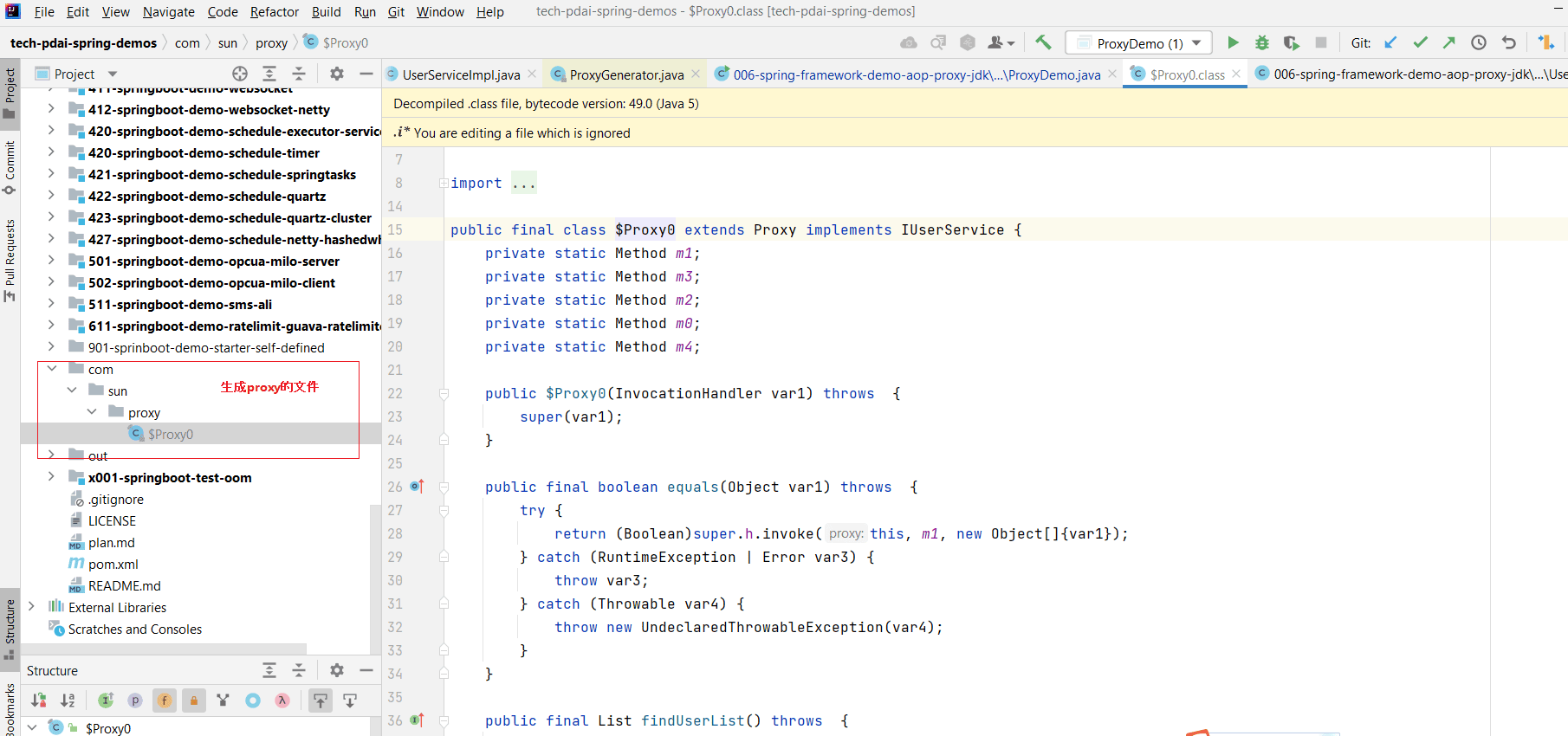
我们看下生成后的代码:
//
// Source code recreated from a .class file by IntelliJ IDEA
// (powered by FernFlower decompiler)
//
package com.sun.proxy;
import java.lang.reflect.InvocationHandler;
import java.lang.reflect.Method;
import java.lang.reflect.Proxy;
import java.lang.reflect.UndeclaredThrowableException;
import java.util.List;
import tech.pdai.springframework.service.IUserService;
// 所有类和方法都是final类型的
public final class $Proxy0 extends Proxy implements IUserService {
private static Method m1;
private static Method m3;
private static Method m2;
private static Method m0;
private static Method m4;
// 构造函数注入 InvocationHandler
public $Proxy0(InvocationHandler var1) throws {
super(var1);
}
public final boolean equals(Object var1) throws {
try {
return (Boolean)super.h.invoke(this, m1, new Object[]{var1});
} catch (RuntimeException | Error var3) {
throw var3;
} catch (Throwable var4) {
throw new UndeclaredThrowableException(var4);
}
}
public final List findUserList() throws {
try {
return (List)super.h.invoke(this, m3, (Object[])null);
} catch (RuntimeException | Error var2) {
throw var2;
} catch (Throwable var3) {
throw new UndeclaredThrowableException(var3);
}
}
public final String toString() throws {
try {
return (String)super.h.invoke(this, m2, (Object[])null);
} catch (RuntimeException | Error var2) {
throw var2;
} catch (Throwable var3) {
throw new UndeclaredThrowableException(var3);
}
}
public final int hashCode() throws {
try {
return (Integer)super.h.invoke(this, m0, (Object[])null);
} catch (RuntimeException | Error var2) {
throw var2;
} catch (Throwable var3) {
throw new UndeclaredThrowableException(var3);
}
}
public final void addUser() throws {
try {
super.h.invoke(this, m4, (Object[])null);
} catch (RuntimeException | Error var2) {
throw var2;
} catch (Throwable var3) {
throw new UndeclaredThrowableException(var3);
}
}
static {
try {
// 初始化 methods, 2个IUserService接口中的方法,3个Object中的接口
m1 = Class.forName("java.lang.Object").getMethod("equals", Class.forName("java.lang.Object"));
m3 = Class.forName("tech.pdai.springframework.service.IUserService").getMethod("findUserList");
m2 = Class.forName("java.lang.Object").getMethod("toString");
m0 = Class.forName("java.lang.Object").getMethod("hashCode");
m4 = Class.forName("tech.pdai.springframework.service.IUserService").getMethod("addUser");
} catch (NoSuchMethodException var2) {
throw new NoSuchMethodError(var2.getMessage());
} catch (ClassNotFoundException var3) {
throw new NoClassDefFoundError(var3.getMessage());
}
}
}上述代码是比较容易理解的,我就不画图了。
主要流程是:
- ProxyGenerator创建Proxy的具体类$Proxy0
- 由static初始化块初始化接口方法:2个IUserService接口中的方法,3个Object中的接口方法
- 由构造函数注入InvocationHandler
- 执行的时候,通过ProxyGenerator创建的Proxy,调用InvocationHandler的invoke方法,执行我们自定义的invoke方法
SpringAOP中JDK代理的实现
SpringAOP扮演的是JDK代理的创建和调用两个角色,我们通过这两个方向来看下SpringAOP的代码(JdkDynamicAopProxy类)
SpringAOP Jdk代理的创建
代理的创建比较简单,调用getProxy方法,然后直接调用JDK中Proxy.newProxyInstance()方法将classloader和被代理的接口方法传入即可。
@Override
public Object getProxy() {
return getProxy(ClassUtils.getDefaultClassLoader());
}
@Override
public Object getProxy(@Nullable ClassLoader classLoader) {
if (logger.isTraceEnabled()) {
logger.trace("Creating JDK dynamic proxy: " + this.advised.getTargetSource());
}
return Proxy.newProxyInstance(classLoader, this.proxiedInterfaces, this);
}SpringAOP Jdk代理的执行
执行的方法如下:
/**
* Implementation of {@code InvocationHandler.invoke}.
* <p>Callers will see exactly the exception thrown by the target,
* unless a hook method throws an exception.
*/
@Override
@Nullable
public Object invoke(Object proxy, Method method, Object[] args) throws Throwable {
Object oldProxy = null;
boolean setProxyContext = false;
TargetSource targetSource = this.advised.targetSource;
Object target = null;
try {
// 执行的是equal方法
if (!this.equalsDefined && AopUtils.isEqualsMethod(method)) {
// The target does not implement the equals(Object) method itself.
return equals(args[0]);
}
// 执行的是hashcode方法
else if (!this.hashCodeDefined && AopUtils.isHashCodeMethod(method)) {
// The target does not implement the hashCode() method itself.
return hashCode();
}
// 如果是包装类,则dispatch to proxy config
else if (method.getDeclaringClass() == DecoratingProxy.class) {
// There is only getDecoratedClass() declared -> dispatch to proxy config.
return AopProxyUtils.ultimateTargetClass(this.advised);
}
// 用反射方式来执行切点
else if (!this.advised.opaque && method.getDeclaringClass().isInterface() &&
method.getDeclaringClass().isAssignableFrom(Advised.class)) {
// Service invocations on ProxyConfig with the proxy config...
return AopUtils.invokeJoinpointUsingReflection(this.advised, method, args);
}
Object retVal;
if (this.advised.exposeProxy) {
// Make invocation available if necessary.
oldProxy = AopContext.setCurrentProxy(proxy);
setProxyContext = true;
}
// Get as late as possible to minimize the time we "own" the target,
// in case it comes from a pool.
target = targetSource.getTarget();
Class<?> targetClass = (target != null ? target.getClass() : null);
// 获取拦截链
List<Object> chain = this.advised.getInterceptorsAndDynamicInterceptionAdvice(method, targetClass);
// Check whether we have any advice. If we don't, we can fallback on direct
// reflective invocation of the target, and avoid creating a MethodInvocation.
if (chain.isEmpty()) {
// We can skip creating a MethodInvocation: just invoke the target directly
// Note that the final invoker must be an InvokerInterceptor so we know it does
// nothing but a reflective operation on the target, and no hot swapping or fancy proxying.
Object[] argsToUse = AopProxyUtils.adaptArgumentsIfNecessary(method, args);
retVal = AopUtils.invokeJoinpointUsingReflection(target, method, argsToUse);
}
else {
// We need to create a method invocation...
MethodInvocation invocation =
new ReflectiveMethodInvocation(proxy, target, method, args, targetClass, chain);
// Proceed to the joinpoint through the interceptor chain.
retVal = invocation.proceed();
}
// Massage return value if necessary.
Class<?> returnType = method.getReturnType();
if (retVal != null && retVal == target &&
returnType != Object.class && returnType.isInstance(proxy) &&
!RawTargetAccess.class.isAssignableFrom(method.getDeclaringClass())) {
// Special case: it returned "this" and the return type of the method
// is type-compatible. Note that we can't help if the target sets
// a reference to itself in another returned object.
retVal = proxy;
}
else if (retVal == null && returnType != Void.TYPE && returnType.isPrimitive()) {
throw new AopInvocationException(
"Null return value from advice does not match primitive return type for: " + method);
}
return retVal;
}
finally {
if (target != null && !targetSource.isStatic()) {
// Must have come from TargetSource.
targetSource.releaseTarget(target);
}
if (setProxyContext) {
// Restore old proxy.
AopContext.setCurrentProxy(oldProxy);
}
}
}CGLIB代理
代理的流程
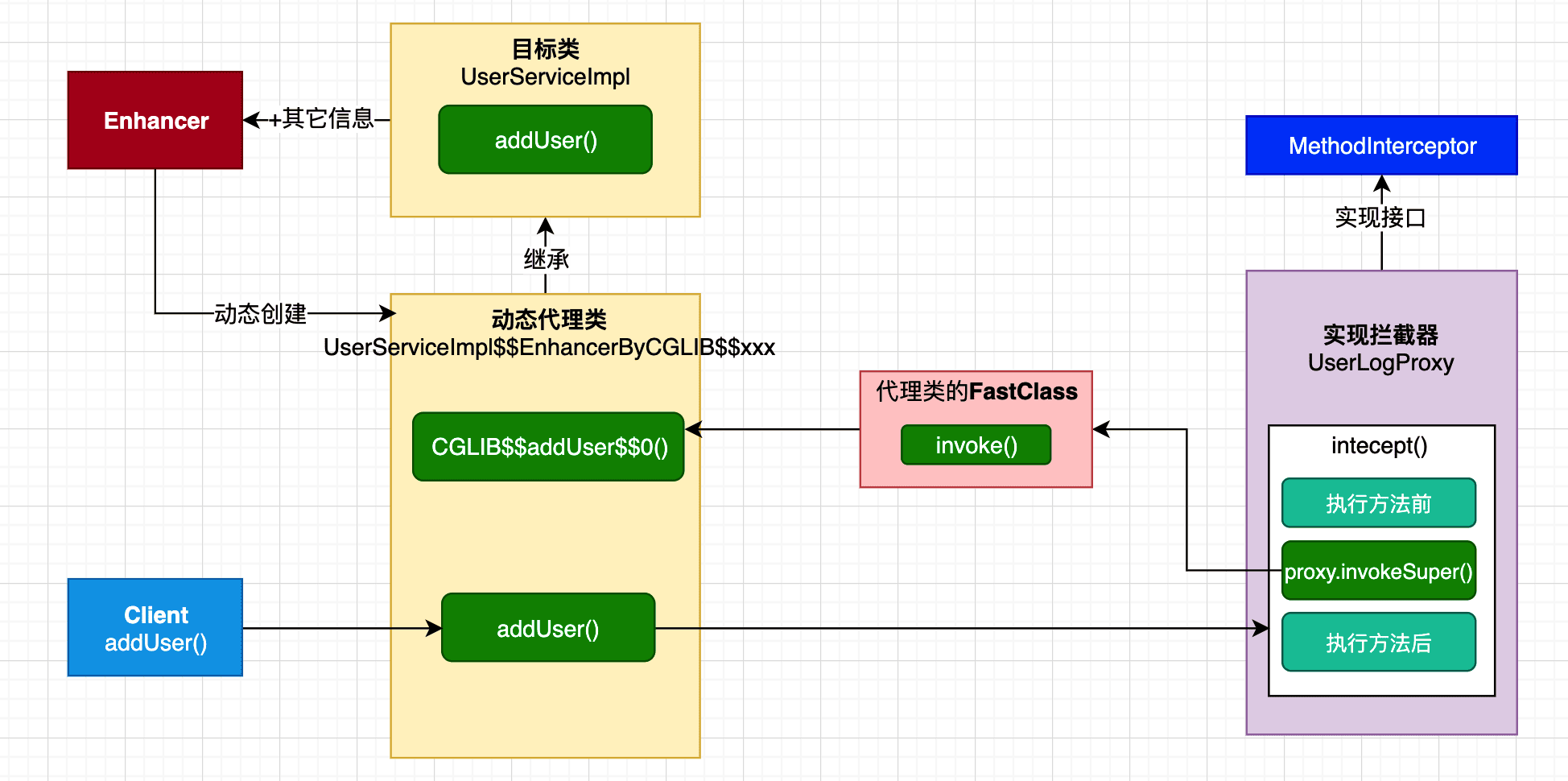
在上图中,我们可以通过在Enhancer中配置更多的参数来控制代理的行为,比如如果只希望增强这个类中的一个方法(而不是所有方法),那就增加callbackFilter来对目标类中方法进行过滤;Enhancer可以有更多的参数类配置其行为,不过我们在学习上述主要的流程就够了。
final方法为什么不能被代理?很显然final方法没法被子类覆盖,当然不能代理了。
Mockito为什么不能mock静态方法?因为mockito也是基于cglib动态代理来实现的,static方法也不能被子类覆盖,所以显然不能mock。但PowerMock可以mock静态方法,因为它直接在bytecode上工作。
SpringAOP中Cglib代理的实现
SpringAOP封装了cglib,通过其进行动态代理的创建。
我们看下CglibAopProxy的getProxy方法
@Override
public Object getProxy() {
return getProxy(null);
}
@Override
public Object getProxy(@Nullable ClassLoader classLoader) {
if (logger.isTraceEnabled()) {
logger.trace("Creating CGLIB proxy: " + this.advised.getTargetSource());
}
try {
Class<?> rootClass = this.advised.getTargetClass();
Assert.state(rootClass != null, "Target class must be available for creating a CGLIB proxy");
// 上面流程图中的目标类
Class<?> proxySuperClass = rootClass;
if (rootClass.getName().contains(ClassUtils.CGLIB_CLASS_SEPARATOR)) {
proxySuperClass = rootClass.getSuperclass();
Class<?>[] additionalInterfaces = rootClass.getInterfaces();
for (Class<?> additionalInterface : additionalInterfaces) {
this.advised.addInterface(additionalInterface);
}
}
// Validate the class, writing log messages as necessary.
validateClassIfNecessary(proxySuperClass, classLoader);
// 重点看这里,就是上图的enhancer,设置各种参数来构建
Enhancer enhancer = createEnhancer();
if (classLoader != null) {
enhancer.setClassLoader(classLoader);
if (classLoader instanceof SmartClassLoader &&
((SmartClassLoader) classLoader).isClassReloadable(proxySuperClass)) {
enhancer.setUseCache(false);
}
}
enhancer.setSuperclass(proxySuperClass);
enhancer.setInterfaces(AopProxyUtils.completeProxiedInterfaces(this.advised));
enhancer.setNamingPolicy(SpringNamingPolicy.INSTANCE);
enhancer.setStrategy(new ClassLoaderAwareGeneratorStrategy(classLoader));
// 设置callback回调接口,即方法的增强点
Callback[] callbacks = getCallbacks(rootClass);
Class<?>[] types = new Class<?>[callbacks.length];
for (int x = 0; x < types.length; x++) {
types[x] = callbacks[x].getClass();
}
// 上节说到的filter
enhancer.setCallbackFilter(new ProxyCallbackFilter(
this.advised.getConfigurationOnlyCopy(), this.fixedInterceptorMap, this.fixedInterceptorOffset));
enhancer.setCallbackTypes(types);
// 重点:创建proxy和其实例
return createProxyClassAndInstance(enhancer, callbacks);
}
catch (CodeGenerationException | IllegalArgumentException ex) {
throw new AopConfigException("Could not generate CGLIB subclass of " + this.advised.getTargetClass() +
": Common causes of this problem include using a final class or a non-visible class",
ex);
}
catch (Throwable ex) {
// TargetSource.getTarget() failed
throw new AopConfigException("Unexpected AOP exception", ex);
}
}获取callback的方法如下,提几个理解的要点吧,具体读者在学习的时候建议把我的例子跑一下,然后打一个断点进行理解。
rootClass: 即目标代理类advised: 包含上文中我们获取到的advisor增强器的集合exposeProxy: 在xml配置文件中配置的,背景就是如果在事务A中使用了代理,事务A调用了目标类的的方法a,在方法a中又调用目标类的方法b,方法a,b同时都是要被增强的方法,如果不配置exposeProxy属性,方法b的增强将会失效,如果配置exposeProxy,方法b在方法a的执行中也会被增强了DynamicAdvisedInterceptor: 拦截器将advised(包含上文中我们获取到的advisor增强器)构建配置的AOP的callback(第一个callback)targetInterceptor: xml配置的optimize属性使用的(第二个callback)- 最后连同其它5个默认的Interceptor 返回作为cglib的拦截器链,之后通过CallbackFilter的accpet方法返回的索引从这个集合中返回对应的拦截增强器执行增强操作。
private Callback[] getCallbacks(Class<?> rootClass) throws Exception {
// Parameters used for optimization choices...
boolean exposeProxy = this.advised.isExposeProxy();
boolean isFrozen = this.advised.isFrozen();
boolean isStatic = this.advised.getTargetSource().isStatic();
// Choose an "aop" interceptor (used for AOP calls).
Callback aopInterceptor = new DynamicAdvisedInterceptor(this.advised);
// Choose a "straight to target" interceptor. (used for calls that are
// unadvised but can return this). May be required to expose the proxy.
Callback targetInterceptor;
if (exposeProxy) {
targetInterceptor = (isStatic ?
new StaticUnadvisedExposedInterceptor(this.advised.getTargetSource().getTarget()) :
new DynamicUnadvisedExposedInterceptor(this.advised.getTargetSource()));
}
else {
targetInterceptor = (isStatic ?
new StaticUnadvisedInterceptor(this.advised.getTargetSource().getTarget()) :
new DynamicUnadvisedInterceptor(this.advised.getTargetSource()));
}
// Choose a "direct to target" dispatcher (used for
// unadvised calls to static targets that cannot return this).
Callback targetDispatcher = (isStatic ?
new StaticDispatcher(this.advised.getTargetSource().getTarget()) : new SerializableNoOp());
Callback[] mainCallbacks = new Callback[] {
aopInterceptor, //
targetInterceptor, // invoke target without considering advice, if optimized
new SerializableNoOp(), // no override for methods mapped to this
targetDispatcher, this.advisedDispatcher,
new EqualsInterceptor(this.advised),
new HashCodeInterceptor(this.advised)
};
Callback[] callbacks;
// If the target is a static one and the advice chain is frozen,
// then we can make some optimizations by sending the AOP calls
// direct to the target using the fixed chain for that method.
if (isStatic && isFrozen) {
Method[] methods = rootClass.getMethods();
Callback[] fixedCallbacks = new Callback[methods.length];
this.fixedInterceptorMap = CollectionUtils.newHashMap(methods.length);
// TODO: small memory optimization here (can skip creation for methods with no advice)
for (int x = 0; x < methods.length; x++) {
Method method = methods[x];
List<Object> chain = this.advised.getInterceptorsAndDynamicInterceptionAdvice(method, rootClass);
fixedCallbacks[x] = new FixedChainStaticTargetInterceptor(
chain, this.advised.getTargetSource().getTarget(), this.advised.getTargetClass());
this.fixedInterceptorMap.put(method, x);
}
// Now copy both the callbacks from mainCallbacks
// and fixedCallbacks into the callbacks array.
callbacks = new Callback[mainCallbacks.length + fixedCallbacks.length];
System.arraycopy(mainCallbacks, 0, callbacks, 0, mainCallbacks.length);
System.arraycopy(fixedCallbacks, 0, callbacks, mainCallbacks.length, fixedCallbacks.length);
this.fixedInterceptorOffset = mainCallbacks.length;
}
else {
callbacks = mainCallbacks;
}
return callbacks;
}可以结合调试,方便理解

AOP在嵌套方法调用时不生效
在一个实现类中,有2个方法,方法A,方法B,其中方法B上面有个注解切面,当方法B被外部调用的时候,会进入切面方法。
但当方法B是被方法A调用时,并不能从方法B的注解上,进入到切面方法,即我们经常碰到的方法嵌套时,AOP注解不生效的问题。
案例
外部调用AOP方法正常进入
通过外部,调用方法B,可以正常进入切面方法,这个场景的代码如下:
- 注解类:
@Target({ElementType.METHOD, ElementType.TYPE})
@Retention(RetentionPolicy.RUNTIME)
public @interface DemoAnno {
}- 切面类
@Aspect
@Order(-1)
@Component
public class DemoAspect {
@Before("@annotation(da)")
public void beforDoSomething(JoinPoint point, DemoAnno da) throws Exception {
System.out.println("before method B, print 'hello,world' " );
}
}- 接口类
public interface DemoService {
void methodDemoA();
void methodDemoB();
}- 服务实现类
@Service
public class DemoServiceImpl implements DemoService {
@Override
public void methodDemoA(){
System.out.println("this is method A");
}
@Override
@DemoAnno
public void methodDemoB() {
System.out.println("this is method B");
}
}- 测试方法
@Autowired
DemoService demoService;
@Test
public void testMethod(){
demoService.methodDemoA();
demoService.methodDemoB();
}输出结果:
this is method A
before method B, print 'hello,world'
this is method B方法嵌套调用,AOP不生效
上面的代码,做下修改。在DemoServiceImpl实现类中,通过方法A去调用方法B,然后再单元测试类中,调用方法A。代码修改后如下:
- 服务实现类:
@Service
public class DemoServiceImpl implements DemoService {
@Override
public void methodDemoA(){
System.out.println("this is method A");
methodDemoB();
}
@Override
@DemoAnno
public void methodDemoB() {
System.out.println("this is method B");
}
}- 输出结果:
this is method A
this is method B原因分析
场景1中,通过外部调用方法B,是由于spring在启动时,根据切面类及注解,生成了DemoService的代理类,在调用方法B时,实际上是代理类先对目标方法进行了业务增强处理(执行切面类中的业务逻辑),然后再调用方法B本身。所以场景1可以正常进入切面方法;
场景2中,通过外部调用的是方法A,虽然spring也会创建一个cglib的代理类去调用方法A,但当方法A调用方法B的时候,属于类里面的内部调用,使用的是实例对象本身去去调用方法B,非aop的cglib代理对象调用,方法B自然就不会进入到切面方法了。
解决方案
但实际上我们期望的是,方法A在调用方法B的时候,仍然能够进入切面方法,即需要AOP切面生效。这种情况下,在调用方法B的时候,需要使用AopContext.currentProxy()获取当前的代理对象,然后使用代理对象调用方法B。
注:需要开启
exposeProxy=true的配置,springboot项目中,可以在启动类上面,添加 @EnableAspectJAutoProxy(exposeProxy = true)注解。
@Service
public class DemoServiceImpl implements DemoService {
@Override
public void methodDemoA(){
System.out.println("this is method A");
DemoService service = (DemoService) AopContext.currentProxy();
service.methodDemoB();
}
@Override
@DemoAnno
public void methodDemoB() {
System.out.println("this is method B");
}
}